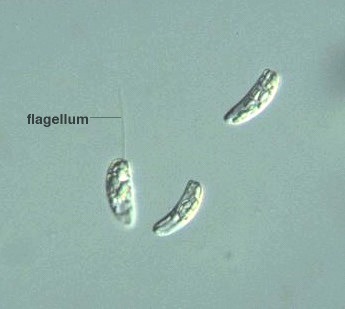
 Rhabdomonas incurva
Rhabdomonas incurva
Fresenius, 1858
 Genus: Emergent flagellum mobile throughout its length during swimming; colourless; no eyespot;
cell body rigid; cylindrical, not flattened; canal opening subapical; paramylon and lipid abundant;
fresh water (Illustrated Guide, 1985).
Body rigid, cylindrical, more or less arched; pellicle longitudinally ridged;
a flagellum at apex (Kudo, 1966).
Genus: Emergent flagellum mobile throughout its length during swimming; colourless; no eyespot;
cell body rigid; cylindrical, not flattened; canal opening subapical; paramylon and lipid abundant;
fresh water (Illustrated Guide, 1985).
Body rigid, cylindrical, more or less arched; pellicle longitudinally ridged;
a flagellum at apex (Kudo, 1966).
Species: Banana-shaped; longitudinal ridges; flagellum as long as cell body;
15-25 μm long,
7-8 μm wide (Hall, 1923),
13-15 μm long,
5-7 μm wide (Hollande, 1952);
standing water (Kudo, 1966).
|
Similar Genus ->> Entosiphon
Rhabdomonas incurva,
cell body banana-shaped, 20 μm long, 7 μm wide, with longitudinal ridges,
a flagellum as long as cell body, 20 μm long, straight at rest,
x 400, x 640, Saitama Pref., Japan, May-June 1999 by Y. Tsukii
 50 μm
50 μm
 100 μm
100 μm
 150 μm; x 400 :
150 μm; x 400 :
 31 μm
31 μm
 63 μm
63 μm
 94 μm; x 640
94 μm; x 640




Rhabdomonas incurva:
Banana-shaped; longitudinal ridges; flagellum as long as cell body;
15-25 μm long,
7-8 μm wide (Hall, 1923),
13-15 μm long,
5-7 μm wide (Hollande, 1952);
standing water (Kudo, 1966).
Rhabdomonas costata (Korschikoff) Pringsheim:
Body curved, cylindrical,
25-30 μm long,
7-10 μm wide,
emergent flagellum 10-20 μm long;
large Golgi bodies just posterior to reservoir; lipid droplets in tail region (Illstrated Guide, 1985).
Please click on images for viewing enlarged.
Copyright
Protist Information Server
 Genus: Emergent flagellum mobile throughout its length during swimming; colourless; no eyespot;
cell body rigid; cylindrical, not flattened; canal opening subapical; paramylon and lipid abundant;
fresh water (Illustrated Guide, 1985).
Body rigid, cylindrical, more or less arched; pellicle longitudinally ridged;
a flagellum at apex (Kudo, 1966).
Genus: Emergent flagellum mobile throughout its length during swimming; colourless; no eyespot;
cell body rigid; cylindrical, not flattened; canal opening subapical; paramylon and lipid abundant;
fresh water (Illustrated Guide, 1985).
Body rigid, cylindrical, more or less arched; pellicle longitudinally ridged;
a flagellum at apex (Kudo, 1966).



